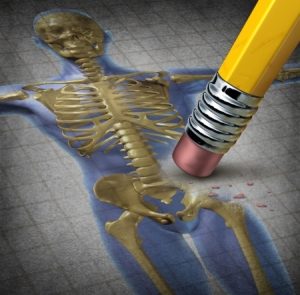Exercise can exhibit noticeable effects on muscle tissue, of course, but it can also affect the body’s main supporting structures – the bones.
The amount of bone we have as young adults is known as the peak bone mass. A person’s amount of at peak bone mass is determined by the body’s ability to make bone. It is influenced by many factors that can cause bone loss over the course of a person’s life. A low peak bone mass raises the risk for developing osteoporosis — a condition marked by weak and brittle bones — later in life.

Enter the Osteoblast
As a living tissue, bone is constantly being absorbed and replaced. The specialized cells that are responsible for breaking down and reabsorb bone are known as osteoblasts. They constitute the major cellular component of bone and they function in groups of connected cells. A group of osteoblasts along with the resultant bone they form is typically referred to as an osteon.
The osteoblastic activity of breaking down and reabsorbing bone continues throughout life. Children and adolescents are continually growing bone until peak bone mass is achieved. At peak bone mass, bone formation and bone reabsorption occurs at equal rates, and remains largely unchanged during the adult years. With age, existing bones are affected by wear and tear and must be replaced with new bone. The process is known as bone remodeling. Osteoporosis is the result of an imbalance in the bone-remodeling process. If bone reabsorption occurs without an equal amount of bone formation, an overall loss of bone occurs. Some factors that affect bone tissue formation include heredity, nutrition, disease, as well as hormonal and biomechanical influences.
Often cited in reference to exercise, Wolff’s law of bone transformation states that mechanical forces acting on bone could cause architectural changes in bone. This means that bone responds to mechanical stress and makes continual changes based on the conditions. That stress can be positive or negative. Exercise, through its ability to lead to bone hypertrophy, is an example of a positive stress. Some research suggests that the magnitude and frequency of force applied affect the stimulation of osteoblastic activity.
When bone formation is not able to keep up with rate of bone reabsorption, the net result is an overall loss of bone, or osteoporosis. Some studies by the Mayo Clinic found that women lose 47 percent of their bone density from the spine, and 39 percent of bone is lost from the wrist during their lifetime.3
Spinal bone loss occurs at a rate of about 1 percent each year. At menopause, when estrogen production is reduced, the rate of bone loss increases to 3 percent or more per year. More recent studies suggest that women may begin to lose bone earlier than previously suspected, and that spinal bone loss may begin in the 40s.
As mentioned, bone formation and reabsorption is influenced by a number of factors, some of which we have no direct say in. Genetics is believed to account for approximately 80 percent, while nutrition, exercise, illness, and estrogen and lifestyle factors, such as alcohol use and smoking, are believed to determine the remaining 20 percent of a person’s ability to generate bone.
Diet
Diet deserves special mention because it is something we can do something about. Some research suggests that high protein intake may exacerbate bone loss in adults. Calcium excretion rises as protein intake increases, especially protein from animal-derived foods. Researchers have discovered that extra dietary protein causes the body to excrete calcium in the urine, which leads to mineral depletion in the bones. Excessive intake of protein may also result in fluid imbalance.
Is There an Exercise Prescription for Bone Health?
Because of the complex of factors that influence bone generation, the amount of exercise training necessary to create an adaptive response for optimal bone tissue is mainly undecided and is highly individual. Until it is known at what threshold level bone responds, the exercise recommendations for intensity, frequency and duration should be based on present knowledge. According to the American College of Sports Medicine (ACSM), program design to optimize bone health should include the following:
-
Weight-bearing exercise such as walking, jogging, dancing, racquet sports, or stair climbing (on real stairs)
-
Resistive training
-
Exercises that place mechanical stress on the spine, femur and wrist
-
Balance and agility activities for fall prevention
-
Exercises performed with correct posture alignment Posture and spine stabilization exercises In addition, the following strengthening exercises are valuable for the spine, wrist and forearm, and the femur.
Strengthening exercises for the spine:
-
Dumbbell Pullover
-
Bent over lateral raise
-
Shoulder shrug
-
Bent over low row
-
Upright row
-
Seated row
-
Lateral raise
-
Lat pulldown
-
Back extension
-
Neck and spine extension
Strengthening exercises for the wrist and forearm:
-
Weighted wrist roll Wrist flexion (curl)
-
Wrist extension
-
Wrist lateral flexion
Strengthening exercises for the femur.
-
Squat
-
Leg press
-
Hip adductor/abductor machine
-
Leg extension
-
Leg curl
-
Lunges
References:
1. Watkins, James. Structure and function of the musculoskeletal system. Champaign: Human Kinetics, 2010.
2. C.H. Chesnut, Bone mass and exercise, Am J Med (1993) (Suppl 5A), pp. 34s-36s.
3. Sydney, L. The Osteoporosis Handbook -Every Woman’s Guide to Prevention and Treatment. Taylor Publishing. 1997
These resources are for the purpose of personal trainer growth and development through Continuing Education which advances the knowledge of fitness professionals. This article is written for NFPT Certified Personal Trainers to receive Continuing Education Credit (CEC). Please contact NFPT at 800.729.6378 or info@nfpt.com with questions or for more information.

